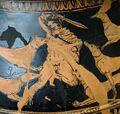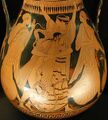Comte de Pourtalès Collection
The Art Collection of James-Alexandre, comte de Pourtalès-Gorgier was a collection of sculpture, antiques and paintings owned by James-Alexandre de Pourtalès, Comte de Pourtalès-Gorgier until his death in 1855.[1]
History
The Comte de Pourtalès-Gorgier (1776–1855), was a Swiss-French banker who served as Chamberlain to the King of Prussia and was awarded the title of Count by King Frederick William III, who ruled Prussia during the Napoleonic Wars and the end of the Holy Roman Empire.[1] The collection was largely held at Hôtel de Pourtalès, his hôtel particulier (essentially a grand townhouse) on Rue Tronchet in the 8th arrondissement of Paris. The collection, which started with a vase,[2] included the Laughing Cavalier by Frans Hals and works by Bronzino, Rembrandt, Jean-Auguste-Dominique Ingres and a Sandro Botticelli portrait.[3] In 1825, he donated a mummy and coffin he acquired from the Thedenat-Duvent sale, to the Berlin Museum.[1] In February and March 1865, ten years after his death, his collection was auctioned off in Paris in accordance with his will. The majority of his collection was photographed and published in a large folio catalog by Goupil & Cie.[4][5] The Laughing Cavalier was purchased by Richard Seymour-Conway, 4th Marquess of Hertford (who outbid Baron James Mayer de Rothschild). William Tyssen-Amherst, 1st Baron Amherst of Hackney bought some of the important Egyptian objects. Sir Charles Thomas Newton spent 60,919 francs on bronzes and vases for the British Museum, and 47,000 francs on Giustiniani's Apollo.[1]
Collection
- Paintings
-
The Landscape Painter by François Boucher
-
Bearing of the Cross with St. Veronica, by Lucas van Leyden, c. 1510s
- Sculpture and pottery
-
Head of the Borghese Hera
-
Apollo, holding his (lost) bow in the right hand and a (lost) laurel branch in the left hand
-
Mercury, holding a lost object, probably a tortoise, 1st century BC
-
Funerary stele of Jason, c. 100 BC
-
Actaeon attacked by his hounds by Dolon Painter
-
Peleus wrestling Thetis and holding her as she transforms into a snake, c. 460 BC
-
Zeus wielding the thunderbolt in his right hand, c. 480–470 BC
-
The Destruction of the Hosts of Pharaoh (front), by Jacques Courtois, early 17th century
-
The Destruction of the Hosts of Pharaoh (back), by Jacques Courtois, early 17th century
References
- Sources
- ↑ 1.0 1.1 1.2 1.3 "Comte James Alexandre de Pourtalès-Gorgier | Collections Online". www.britishmuseum.org. British Museum. Retrieved 9 May 2020.
- ↑ "Pourtalès-Gorgier, James-Alexandre, Comte de". www.oxfordartonline.com. Grove Art Online. 2003. doi:10.1093/gao/9781884446054.article.T069086. ISBN 978-1-884446-05-4. Retrieved 14 May 2020.
- ↑ "Pourtalès, James Alexandre de". hls-dhs-dss.ch (in français). Dictionnaire Historique de la Suisse. Retrieved 9 May 2020.
- ↑ Walters, Vivienne J. (1974). The Cult Fo Mithras in the Roman Provinces of Gaul. Brill Archive. p. 145. ISBN 978-90-04-04014-4. Retrieved 14 May 2020.
- ↑ Entwistle, Chris (2016). Through a Glass Brightly: Studies in Byzantine and Medieval Art and Archaeology Presented to David Buckton. Oxbow Books. p. 220. ISBN 978-1-78570-274-7. Retrieved 14 May 2020.
- ↑ 6.0 6.1 6.2 6.3 6.4 "Pourtalès-Gorgier, James-Alexandre, comte de 1776 - 1855". www.nga.gov. National Gallery of Art. Retrieved 14 May 2020.
- Further reading
- Pourtalès-Gorgier. Catalogue des Objets d'Art et de haute curiosité, antiques, du moyen age et de la renaissance, qui cornposent les Collections de feu M. le Comte de Pourtalès-Gorgier (in French), Paris 1865








